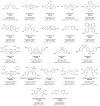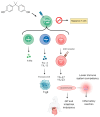Endocrine Disrupting Toxicity of Bisphenol A and Its Analogs: Implications in the Neuro-Immune Milieu
- PMID: 39846545
- PMCID: PMC11755641
- DOI: 10.3390/jox15010013
Endocrine Disrupting Toxicity of Bisphenol A and Its Analogs: Implications in the Neuro-Immune Milieu
Abstract
Endocrine-disrupting chemicals (EDCs) are natural or synthetic substances that are able to interfere with hormonal systems and alter their physiological signaling. EDCs have been recognized as a public health issue due to their widespread use, environmental persistence and the potential levels of long-term exposure with implications in multiple pathological conditions. Their reported adverse effects pose critical concerns about their use, warranting their strict regulation. This is the case of bisphenol A (BPA), a well-known EDC whose tolerable daily intake (TDI) was re-evaluated in 2023 by the European Food Safety Authority (EFSA), and the immune system has been identified as the most sensitive to BPA exposure. Increasing scientific evidence indicates that EDCs can interfere with several hormone receptors, pathways and interacting proteins, resulting in a complex, cell context-dependent response that may differ among tissues. In this regard, the neuronal and immune systems are important targets of hormonal signaling and are now emerging as critical players in endocrine disruption. Here, we use BPA and its analogs as proof-of-concept EDCs to address their detrimental effects on the immune and nervous systems and to highlight complex interrelationships within the immune-neuroendocrine network (INEN). Finally, we propose that Receptor for Activated C Kinase 1 (RACK1), an important target for EDCs and a valuable screening tool, could serve as a central hub in our toxicology model to explain bisphenol-mediated adverse effects on the INEN.
Keywords: BDNF; EDC; HPA axis; INEN; RACK1; glucocorticoids; immune system; in vitro screening tool; neurodegeneration; system toxicology.
Conflict of interest statement
The authors declare no conflicts of interest.
Figures




References
-
- Galbiati V., Buoso E., d’Emmanuele di Villa Bianca R., Paola R.D., Morroni F., Nocentini G., Racchi M., Viviani B., Corsini E. Immune and Nervous Systems Interaction in Endocrine Disruptors Toxicity: The Case of Atrazine. Front. Toxicol. 2021;3:649024. doi: 10.3389/ftox.2021.649024. - DOI - PMC - PubMed
-
- Manley K., Han W., Zelin G., Lawrence D.A. Crosstalk between the immune, endocrine, and nervous systems in immunotoxicology. Curr. Opin. Toxicol. 2018;10:37–45. doi: 10.1016/j.cotox.2017.12.003. - DOI
Publication types
Grants and funding
- Grant Agreement No. 101057014/European Partnership for the Assessment of Risks from Chemicals (PARC) under the Horizon Europe Research and Innovation Programme
- PRIN2017, Project number 2017MLC3NF/Ministero dell'Istruzione, dell'Università e della Ricerca
- PRIN2020, Project number 202039WMFP/Ministero dell'Istruzione, dell'Università e della Ricerca
LinkOut - more resources
Full Text Sources

